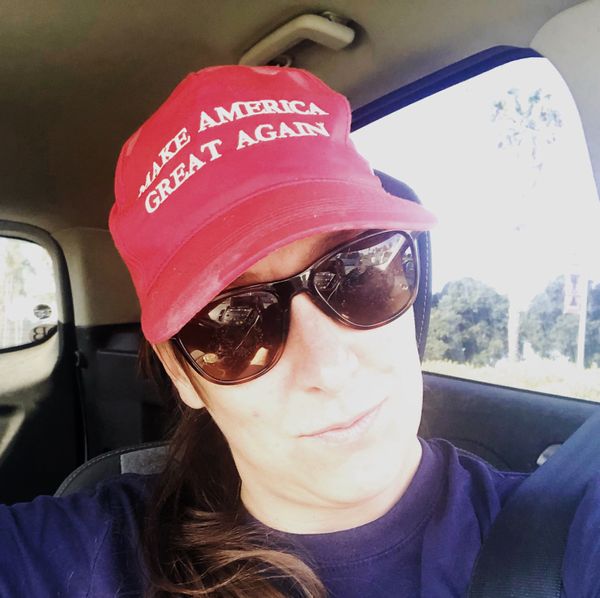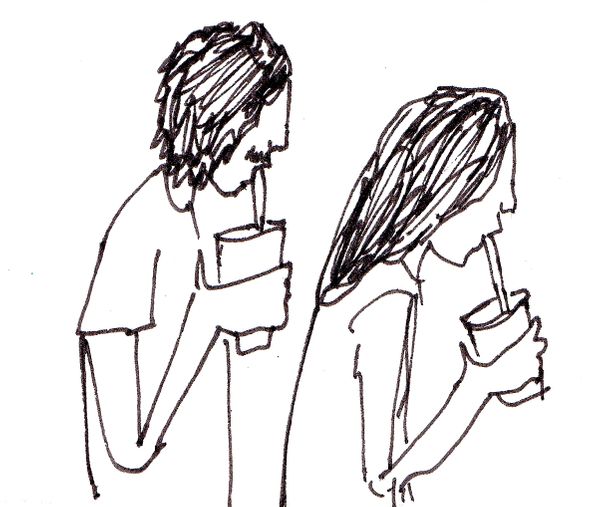by Daniel Girma
Ashli Babbitt, in her final video, filmed herself marching towards the Capitol. She was sure that her country was failing her: The world was on pause over a hoax virus; left-wing terrorists burned cities to the ground last June and the government did nothing. She and her fellow citizens were implored to stay at home, wear masks outside, and vote by mail in the most fraudulent election of the country’s history. Biden, who she had voted for eight years before, would submit the country to communism. The rot had infested so deeply and spanned so widely that there was no other option but to fly across the country and save America's soul.
“There is a sea of nothing but red, white and blue,” Babbitt said to the camera as she made her way down the Inaugural Path, “3 million-plus people.” Elated, she blessed America.
Two hours later, Babbitt was shot and killed by a plainclothes police officer while trying to enter the Speaker’s Lobby. The conspiracies infected her mind like a cordycep, leading her to die where the consequences of Trump’s America could gain maximum exposure to us all. The far right immediately dubbed her a martyr for the cause, daring to compare her to Breonna Taylor and Heather Heyer. But her death inspired little sympathy from most. A veteran of the Air Force, she had failed to uphold her oath to the country. On her Twitter page, she actively supported violence towards lawmakers. White privilege allowed her to believe she could storm the halls of government without fear for her life, even as the officer, gun loaded and pointing at her, ordered her to stand back. To her last breath, Babbitt acted like someone who knew nothing would go wrong. Many cheered and jeered at her death, photoshopping her face on joints because she got “smoked”, and mockingly responding to her tweets post-mortem.
On the left, at least in the mainstream, there is a consensus: Ashli Babbitt betrayed her country, and her death, however gruesome, was justified. But while Babbitt’s place in history is clear, the stance on how law enforcement officials conducted themselves during the attack isn’t. There is debate over whether the Capitol Police were complicit in the insurrection or negligent but loyal in defending Capitol Hill, and there is plenty of proof for both sides to draw from. For every video of a police officer letting Trump supporters through barricades there is one of another facing a sea of maskless, flag-waving, cross-planting rioters on their own. An officer taking selfies with those who breached the building is contrasted by one of their colleagues being crushed in the middle of a giant pushing match between the Capitol Police and scores of rioters trying to get inside. The overall soft treatment of the MAGA crowd compared to how left-wing protesters were treated during the George Floyd Riots conflicts with the naked truth that a police officer died after only one day of defending the Capitol, while there are none whose deaths can be directly linked to the George Floyd protests.
The argument is now starting to settle on a position that would have been ridiculed six months ago: While there is a systemic problem with the police, some are doing what they can. The charge of complicity has not been filed for at least some of the men and women who faced the January 6 siege, such as the officer who survived being crushed and expressed that it was his pleasure to fight white supremacists; certainly not for officer Brian Sicknick, who perished at the hands of the insurrectionists. His is the only other death that day that can be tied to an explicit, violent act. But unlike Babbitt, whose death can be viewed from at least four angles, and who was seen on live television being carted to an ambulance with an EMT performing chest compressions on her blood-soaked torso, there is no confirmed footage of Sicknick’s death. The speculation surrounding it has reached propaganda levels. After footage was posted of a police officer being dragged down the steps of the Capitol while being beaten with an American flag, people online stated that it was Sicknick without any proof. It was a grim example of how we manufacture our own narratives.
If we rolled time back just one day before both Sicknick’s and Babbitt’s deaths, we wouldn’t be able to predict how differently the two would be perceived. They were both veterans of the Iraq and Afghanistan wars. Both were longtime Trump supporters who donated money for the first time in 2020. Babbitt was vocal on Twitter about her belief in QAnon conspiracies; Sicknick quietly followed a number of QAnon influencers on Parler. On their profiles alone, the two are more like compatriots than adversaries.
In death, their worlds were similarly torn apart. Both were abandoned by Donald Trump. The president has not said either of their names, neither to honor Sicknick’s sacrifice nor admonish Babbitt’s sedition. The right wing conspiracy Babbitt gave her life for is rudderless and fractured in the president’s absence from social media, and the Capitol Police force that Sicknick swore to serve faces a reckoning over its conduct on January 6th. Their families had to learn of the deaths through the media, and neither have been contacted by the White House.
One fateful difference separates Babbitt and Sicknick’s legacies: their conduct during the Capitol invasion itself. That two people with such similar backgrounds, influences, and abrupt ends would die as foes on the battlefield and martyrs for competing visions of America is a cruel irony. How alone they were together, arriving at such different places after being sold the same bill of goods. It is a painful example of how our capacity to receive, understand, and engage with the world and each other—something that has always been lower than claimed in America—is all but lost now, and how easily we can be taken advantage of. If we are going to solve this problem, we must stop dismissing the context behind what people do wrong. “At the end of the day, they made a choice” is too shallow an interpretation.
Babbitt was right about one thing. Her country was failing her. Rather than improve the lives of all citizens, America has been striving for a middle ground of mutual suffering. Financial inequity is increasing across the board. Among fellow democracies, the United States has built a reputation of leading in the wrong ways. Although a feared loss of privilege led many to flock to Trump, there was real loss as well. His failures in office, no matter how egregious, still couldn’t compete with decades of decline in white America, which voted for him again in 2020. Even the almost 400,000 lives lost to a once-in-a-lifetime pandemic could not lift the veil for many like Babbitt, who held it tightly over her eyes, her knuckles whitening under the strain. Would she still hold on if she had lived only to be betrayed again?
Ashli Babbitt’s death cannot be compared to those of Breonna Taylor or Heather Heyer. Their names should never be uttered in the same breath. Taylor was a victim of the terrible power that the police have in our country. Heyer was killed because she dared to stand up for a more just society that would free itself from the trappings of race. Babbitt, ultimately, was a victim of her own delusions, and marched to her own doom in the halls of democracy because she couldn’t fathom a presidency post-Trump. But all three are examples of how far this country is from what it claims to be, and even further from what it aspires to. All three are marks of decline, ridges in the sand left by an ebbing nation. There is nothing to celebrate in that.
Daniel Girma is Laid Off NYC's Content Curator and co-edits our Politics section. Get to know him better: @dangirmanyc



